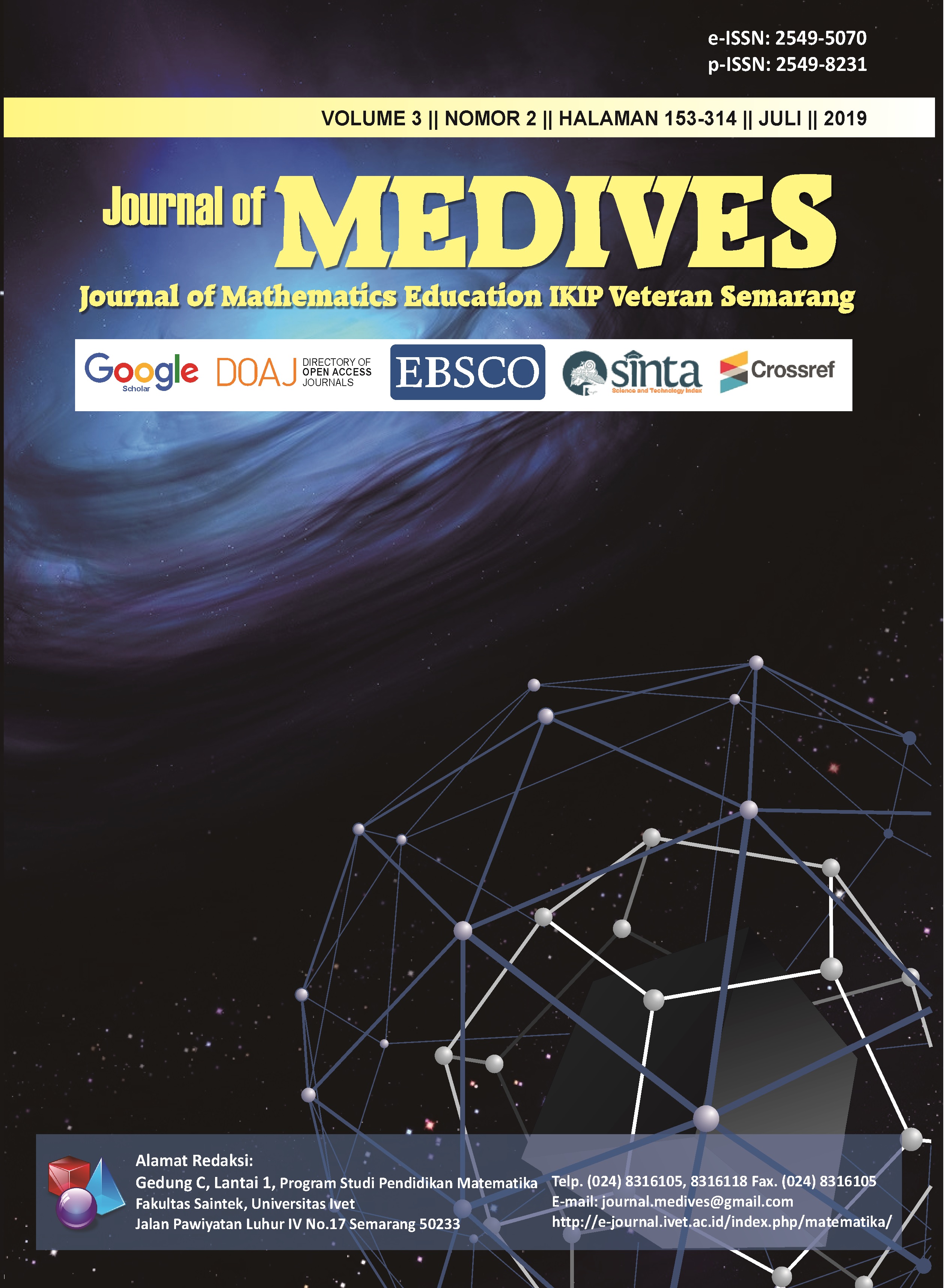Analisis Struktur Kognitif Siswa Kelas IV Sekolah Dasar dalam Menyelesaikan Masalah Pembagian Bilangan Bulat
Abstract
Pembelajaran yang lebih ditekankan pada prosedur dan hasil dalam penyelesaian masalah tidak akan mengaktifkan strukur kognitif (berpikir) siswa dan tidak meningkatkan kemampuan berpikir matematis. Siswa hanya akan meniru prosedur yang dilakukan guru. Penelitian ini merupakan studi kasus pembelajaran matematika di kelas IV sekolah dasar pada materi pembagian bilangan bulat. Tujuan penelitian adalah mendeskripsikan struktur kognitif siswa dalam menyelesaikan masalah. Penelitian menggunakan metode kombinasi (kualitatif-kuantitatif) dengan desain concurrent embedded. Teknik pengumpulan data dilakukan secara trianggulasi yaitu observasi partisipan, wawancara yang mendalam, serta studi dokumentasi. Hasil penelitian menunjukkan bahwa struktur kognitif Siswa A memiliki struktur kognitif komparatif dan siswa B memiliki struktur kognitif penalaran logis. Siswa menggunakan struktur kognitif untuk memproses informasi dan menciptakan makna dengan cara (1) membuat koneksi, (2) menemukan pola, (3) mengidentifikasi aturan, dan (4) mengabstraksikan prinsip-prinsip.
Kata kunci: struktur kognitif, berpikir matematis, bilangan bulat.
ABSTRACT
Learning that is more emphasized on procedures and results in solving problems will not activate the cognitive structure (thinking) of students and does not improve the ability to mathematical thinking. Students will only imitate the procedures performed by the teacher. This research is a case study of mathematics learning in the fourth grade of elementary school in integer division material. The research objective is to describe the cognitive structure of students in solving problems. The study uses a combination method (qualitative - quantitative) with concurrent embedded design. The data collection technique is done in triangulation, namely participant observation, in-depth interviews, and documentation studies. The results showed that the cognitive structure of class IV students reached the level of comparative cognitive structure (group A) and cognitive structure of logical reasoning (group B). Students use cognitive structures to process information and create meaning by (1) making connections, (2) finding patterns, (3) identifying rules, and (4) abstracting principles
Keywords: cognitive structure, mathematical thinking, integers.
Downloads
References
Betty K. Garner. (2012). Getting to Got It: Helping Struggling Students Learn How to Learn. Association for Supervision and Curriculum Development (ASCD).1703 North Beauregard St. Alexandria, VA 22311-1714. Retrieved from http://www.ascd.org/publications/books/107024/chapters/Cognitive-Structures@-What-They-Are-and-Why-They-Matter.aspx
Bormanaki, H. B., & Khoshhal, Y. (2017). The Role of Equilibration in Piaget ’ s Theory of Cognitive Development and Its Implication for Receptive Skills?: A Theoretical Study. Journal of Language Teaching and Research, 8(5), 996–1005.
Joubish, M. F., & Khurram, M. A. (2011). Cognitive Development in Jean Piaget’s Work and its Implications for Teachers. World Applied Sciences Journal, 12(8), 1260–1265. Retrieved from https://pdfs.semanticscholar.org/4d5b/346602122c634fba7bb9535cd1db18018b48.pdf
Kuldas, S., Ismail, H. N., Hashim, S., & Bakar, Z. A. (2013). Unconscious Learning Processes: Mental Integration of Verbal and Pictorial Instructional Materials. SpringerPlus_a Springer Open Journal, 2(1), 105–121. https://doi.org/10.1186/2193-1801-2-105
Miles, M. B., & Huberman, M. A. (2012). Analisis Data Kualitatif: Buku Sumber Tentang Metode-Metode Baru. Universitas Indonesia_UI Press (11th ed.). Jakarta: Universitas Indonesia (UI-Press).
Navaneedhan, C., & Kamalanabhan, T. (2017). What Is Meant by Cognitive Structures?? How Does It Influence Teaching – Learning of Psychology?? IRA International Journal of Education and Multidisciplinary Studies, 7(2), 89–98. https:// doi.org/10.21013/jems.v7.n2.p5
Nayazik, A. (2017). Pembentukan Keterampilan Pemecahan Masalah melalui Model IDEAL Problem Solving dengan Teori Pemrosesan Informasi, 8(2), 182–190.
Ojose, B. (2008). Applying Piaget ’ s Theory of Cognitive Development to Mathematics Instruction. Journal The Mathematics Educator, 18(1), 26–30.
Pechtel, P., & Pizzagalli, D. A. (2011). Effects of Early Life Stress on Cognitive and Affective Function:An Integrated Review of Human Literature. Psychopharmacology, 214(1), 55–70. https:// doi.org/10.1007/s00213-010-2009-2
Rehalat, A. (2014). Model Pembelajaran Pemrosesan Informasi. Jurnal Pendidikan Ilmu Sosial, 23(2), 1–11.
Sugiyono. (2012). Metode Penelitian Kombinasi (Mixed Method) (3rd ed.). Bandung: Alfabeta. Retrieved from https://anzdoc.com/sugiyono2014-metode-penelitian-kombinasi-mixed-methods-band...%0A
Vaivre-douret, L. (2011). Developmental and Cognitive Characteristics of “ High-Level Potentialities ” ( Highly Gifted ) Children. International Journal of Pediatrics, August, 1–14. https://doi.org/10.1155/2011/420297

This work is licensed under a Creative Commons Attribution 4.0 International License.
The copyright for all articles belongs to the authors. All other copyright is held by the journal.






